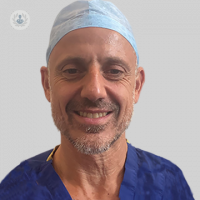Managing your headache
Written by:Headaches can come in various shapes and sizes, from common tension headaches to cluster headaches and migraines and the way to manage them depends on the type. There are many options, but don’t worry! Leading neurosurgeon Mr Sinan Barazi, part of the London Neurosurgery Partnership, is here with a handy guide to headache management.

Tension headache
Tension headaches are very common and don’t tend to be too severe. They typically manifest as a constant ache on both sides of the head. Other possible symptoms include a tightening of the neck muscles and even feeling of strain behind the eyes. These headaches can last from several minutes to a few hours. They are usually not severe enough to have a significant impact on the patient’s day.
The following tips for self-management are usually sufficient to make a tension headache disappear:
- Drink plenty of water.
- Rest, especially if you also have a cold or flu.
- Exercise (if you feel up to it).
- Take over-the-counter painkillers like paracetamol or ibuprofen.
Sinus headache
Sinus headaches are a symptom of sinusitis, caused when the upper airways and the lining of the nose become infected and swell, blocking the sinuses. This causes pressure to build up, which, in turn, causes the headache. Sinus headaches are actually relatively uncommon – many times people who think they have a sinus headache are actually suffering from a tension headache or migraine.
Sinus headaches tend to affect one side of the head and may worsen in certain positions, such as when your head is leaning forward. Patients may experience throbbing around the forehead, cheeks, and eyes and the face may feel tender or swollen.
You can manage a sinus headache in the following ways:
- Take over-the-counter painkillers, e.g. paracetamol or ibuprofen.
- Get lots of rest.
- Stay hydrated.
- Decongestants can help clear the blocked sinuses and help relieve the tension they are causing.
- Saline nasal sprays can help to reduce swelling in the nose.
- Holding a warm flannel on the nose can also help reduce congestion.
Cluster headache
Cluster headaches appear quickly, usually without any warning signs, and arrive as a piercing sensation in the side of the head accompanied by a burning sensation or a sharp pain that radiates across the temple towards the eye. They occur in patterns and tend to recur every day, usually around the same time, for a period of several weeks to several months, and then go away. Patients may go weeks, months, or even years before another attack. However, for many people, they occur at similar times of year. Cluster headaches are described as being excruciatingly painful.
Standard pain relief like paracetamol is not generally fast-acting enough to deal with cluster headaches. You should consult your GP or a specialist, as they will be able to prescribe stronger medication or other treatments to deal with these intense headaches. Examples include:
- Sumatriptan injections – these can generally be self-administered up to twice a day.
- Sumatriptan or Zolmitriptan nasal spay
- Oxygen therapy – the patient breathes pure oxygen through a face mask.
These treatments can usually relieve the pain within half an hour.
Learn more about cluster headaches with Mr Barazi
Despite the severity and relatively common incidence of cluster headaches, not everyone is aware of what they are, and as such, many sufferers do not know how they can manage their headaches. However, Mr Barazi at the London Neurosurgery Partnership is here to answer all your questions and help manage your headaches.


